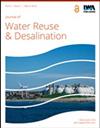膜法与高级氧化法联合处理橄榄废水的技术经济分析
IF 2.3
Q2 Environmental Science
引用次数: 6
摘要
本文提出了一种可靠的橄榄厂废水处理工艺。为了开发更具可持续性的多酚回收和水再利用工艺,根据废水特性,使用过程模拟器(SuperPro Designer)模拟了两种处理方案;第一个应用于使用膜技术(微滤MF、超滤UF、纳滤NF和反渗透RO)的“生物”废水,第二个用于含农药废水,其中RO被高级氧化工艺取代,用于农药降解。过程分析结果表明,最终渗透水是一种处理后的水,既适合在水生受体中处理,也适合民用或农业回用。此外,通过生命周期成本分析,考虑到从过程分析中获得的质量和能量平衡,提出了所提议过程的技术经济分析结果。分析表明,第一种方案在经济上更可行。具体而言,第一个和第二个案例研究的治疗费用(OMWW€/m)分别为253欧元和292欧元/m。但是,如果要处理的废水不是来自生物橄榄加工,则第二种工艺方案结果不合适。本文章由计算机程序翻译,如有差异,请以英文原文为准。
Techno-economic analysis of olive wastewater treatment with a closed water approach by integrated membrane processes and advanced oxidation processes
In this paper, a reliable treatment process for olive mill wastewaters (OMWW) is proposed. In order to develop a more sustainable process with polyphenols recovery and water reuse, two treatment schemes have been simulated by using a process simulator (SuperPro Designer), depending on wastewater characteristics; the first applied for ‘biological’ effluents by using membrane technology (microfiltration MF, ultrafiltration UF, nanofiltration NF and reverse osmosis RO), the second for wastewaters containing pesticides, in which RO is replaced with an advanced oxidation process for pesticide degradation. The results of the process analysis showed that the final permeate is a treated water suitable for both disposal in aquatic receptors and for civil or agriculture reuse. Moreover, the results of a techno-economic analysis of the proposed processes is presented, carried out by means of a life cycle cost analysis, considering the mass and energy balances obtained from process analysis. The analysis showed that the first scenario is more economically feasible. In detail, the treatment cost (€/m of OMWW) was 253 and 292 €/m for the first and second case study, respectively. However, the second process scheme result is inappropriate if the wastewater to be treated does not come from biological olive processing.
求助全文
通过发布文献求助,成功后即可免费获取论文全文。
去求助
来源期刊

Journal of Water Reuse and Desalination
ENGINEERING, ENVIRONMENTAL-WATER RESOURCES
CiteScore
4.30
自引率
0.00%
发文量
23
审稿时长
16 weeks
期刊介绍:
Journal of Water Reuse and Desalination publishes refereed review articles, theoretical and experimental research papers, new findings and issues of unplanned and planned reuse. The journal welcomes contributions from developing and developed countries.
 求助内容:
求助内容: 应助结果提醒方式:
应助结果提醒方式:


